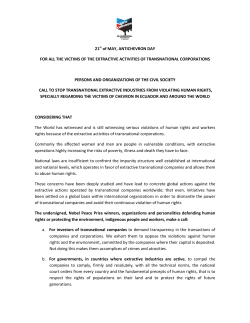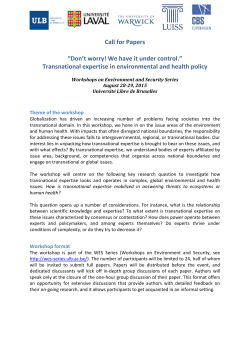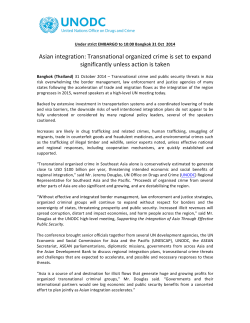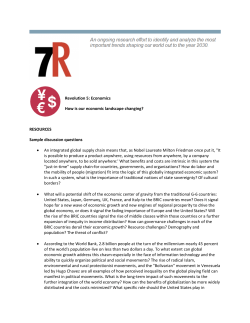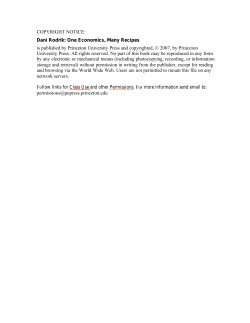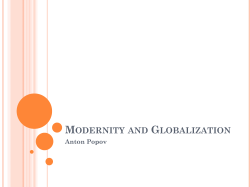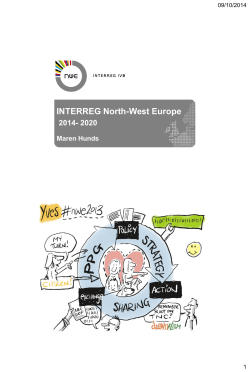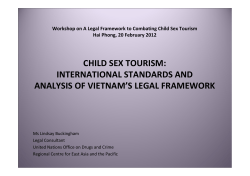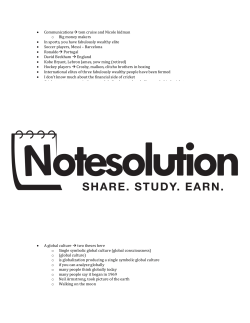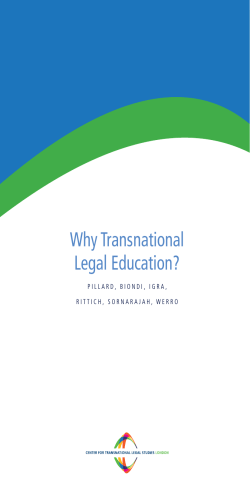
Globalization, Migration, and Women across the World WOM 101
Globalization, Migration, and Women across the World WOM 101 Economic Globalization • Growing trend of a world economy dominated by transnational corporations impacts women • Economic globalization: the integration and rapid interaction of economies through production, trade, and financial transactions by banks and multinational corporations, with an increased role for the World Bank and the International Monetary Fund, as well as the World Trade Organization Cultural Globalization • The transnational migration of people, information and consumer culture Critiques of Globalization • Benefits are not distributed equally across nations • More affluent northern governments provide subsidies to their farmers so that they can afford to sell their products for less in the global market • Farmers from southern countries where subsidies are unavailable are unable to compete and become poorer • Northern governments also frequently impose tariffs and import limits on goods from other countries. This keeps cheaper goods out of the home market and protects the profits of corporations in the home country • Liberalized trade agreements eroded workers’ rights and unionization. • Environmental sustainability is compromised when poor countries, desperate for a piece of the global economic pie, let transnational corporations exploit or pollute their national resources Effects of Globalization on Women • Mixed effects on women’s employment: associated with increases in women’s paid employment but those jobs created are typically low-paid factory work or domestic work • Economic shifts that come with globalization come may create additional layers of paid and unpaid labor and force women to migrate to other countries for work. Outsourcing • "Outsourcing" involves transferring or sharing management control and/or decision-making of a business function to an outside supplier, which involves a degree of two-way information exchange, coordination and trust between the outsourcer and its client. Such a relationship between economic entities is qualitatively different from traditional relationships between buyer and seller of services in that the involved economic entities in an "outsourcing" relationship dynamically integrate and share management control of the labor process rather than enter in contracting relationships where both entities remain separate in the coordination of the production of goods and services. Business segments typically outsourced include information technology, human resources, facilities and real estate management, and accounting. Many companies also outsource customer support and call center functions, manufacturing and engineering. Consequently, a debate has ensued concerning the benefits and costs of the practice as well as how to categorize it as a phenomenon. Transnational (or multinational) corporations • Outsourcing of “Electronic labor” a recent phenomenon • Employ women to do clerical work in offshore “Electronic sweatshops,” mostly in the Caribbean • “Infomatics” industry” include telemarketing but are mostly data-entry jobs for banks, insurance companies, a and airlines • For instance, at one Barbados infomatics location, 100 women sit clustered at computer stations and daily enter 300,000 ticket stubs for one airline’s 2000 daily flights. One floor below, an equal number of women enter medical insurance claims data from one of the largest US insurance companies Transnational (or multinational) corporations • Transnational/multinational corporation or enterprise that manages production establishments or delivers services in at least two countries. Very large multinationals have budgets that exceed those of many countries. Multinational corporations can have a powerful influence in international relations and local economies. Multinational corporations play an important role in globalization; some argue that a new form of MNC is evolving in response to globalization—e.g. the 'globally integrated enterprise'. • Knowledge-intensive aspects of the production process often remain in western countries but labor-intensive activities are subcontracted to factories in developing countries where cheap female labor is abundant • US was first to relocate/“outsource” (: to procure (as some goods or services needed by a business or organization) under contract with an outside supplier <decided to outsource some back-office operations>) Transnational (or multinational) corporations • Free Trade Zones/Export Processing Zones— established in many third world/developing countries to attract transnational factories. In these zones, companies are generally exempt from labor, health, and safety, and environmental laws and pay few if any taxes. More than 60 countries have established FTZ’s. • In Honduras alone, there are eleven FTZ’s with 200 factories employing 100,000 people Transnational (or multinational) corporations • Women constitute over 80% of the workers in EPZs in Mexico, Taiwan, Sri Lanka, Malaysia and the Philippines, and more than 70\% in South Korea and Guatemala— they are the preferred labor supply because they can be hired for lower pay and under less desirable working conditions. • Sweatshops: businesses that violate wage, child labor, and safety standards. • Many factories in EPZ’s are little more than sweatshops. workers are unlikely to complain because they need the work despite the conditions Transnational (or multinational) corporations • Maquiladoras: factories in Mexico’s border towns. Another example of women in the transnational corporate factory – – – – • • • 2000 multinational corporations employ over a half million workers, 2/3 of them women, who get paid between $3.75 and $4.50 a day. In El Salvador, women employees of the Taiwanese maquilador Mandarin work shifts of 12021 hours during which they are seldom allowed bathroom breaks. They are paid 10 cents per shirt which are later sold for $20.00 each. The company makes clothes for J. Crew, Eddie Bauer, and the Gap Bangladesh: women sewing clothing at Disney’s contract plans are paid 5 cents for every 17.99 Winnie the Pooh shirt they assemble In Vietnam, 90% of Nike’s workers are females between the ages of 15 and 28. Nike’s labor for a pair of basketball shoes (which retail for 150.00) costs 1.60 Contrary to popular belief, these wages are generally insufficient to escape poverty. For example, sweatshop workers in Nicaragua average from $55.00 to $75.00 a month when the average family needs $165.00 per month to make ends meet In Indonesia, the government estimates that the minimum wage there is equal to just 67% of what is required to meet minimum physical needs In Vietnam, a living wage is estimated to be $3.00 a day, but Nike workers make $1.60 a day Transnational (or multinational) corporations • Women in the transnational factory typically have little choice other than to accept these conditions – – – – – From rural areas and unaware of rights Young Fear of losing jobs Work with forged birth certificates Alternatives are grim (NE Thailand where poverty is so bad that parents sometimes sell their daughter into sex slavery or as cheap labor) Globalization and migration • Globalization makes economic survival difficult in some countries, leading poor women to migrate to more affluent countries where there is a strong demand for low-wage workers • They service the upper-income and corporate beneficiaries of globalization. They typically send anywhere from half to nearly all of what they earn home to their families • Governments in some countries such as Sri Lanka and the Philippines encourage women to migrate because the money sent home contributes to the economy Types of Work • Reflective of traditional gender roles – – – – – – Janitors Maids Nannies Sex workers Nurses and home health workers Sometimes brides to American and European men seeking traditional marriages – Language, cultural barriers, and economic desperation interfere with migrant working women asserting their rights as women and workers, especially for undocumented workers Domestic Service • • • • • Movement of educated women in northern countries into the workforce Gender role changes and rise in female-headed households contribute Advertising creates a consumer culture that requires 2 incomes to sustain Research shows that women’s entry into the workforce has barely impacted the amount of childcare and household labor performed by men Domestic work is neither socially nor intellectually fulfilling but is chosen for economic reasons – Clean up dirt and mess of others, provide love and care to the children of others while their own children are cared for by family members in another country – Quietly do whatever they are asked no matter how gross – Work long, physically demanding hours in other people’s homes where they must act invisible – Feelings of isolation and loneliness are common – Subject to abuse Mail Order Brides • Women in poor economic circumstances who are marketed as brides to men in advanced capitalist countries. They use commercial organizations to arrange introductions and broker marriages with foreign men • Substitutes for women in industrialized countries who resist conventional forms for marriage • By the 1990s, mail order bride agencies market women from Philippines, India, Thailand, Eastern Europe, and Russia. Primarily they marry men in the US, Japan, Europe, and Australia • The industry promotes stereotypes and exploitative relationships in both sides: to brides, they emphasize the wealth of foreign husbands and to husbands, the emphasize the obedience and subservience of foreign women • No firm statistics exist, but immigration officials estimate 200 international matchmaking services, arranging 4000-6000 marriages each year Sexual Tourism • Sex work connected to tourism • Effect of globalization • Arises out of a globalized economy that makes sex work one of the only ways for women to earn a living wage • Governments that need the money from international tourism are willing to encourage, or at least ignore sexual tourism • First world men that eroticize dark-skinned native bodies buy sex in developing countries for cut-rate prices Sexual Tourism • • • • Sex tourists come primarily from Australia, Canada, France, German, Japan, Kuwait, New Zealand, Norway, Qatar, Saudi Arabia, Sweden, the UK, the US Destinations are Brazil, Cambodia, Costa Rica, Cuba, the Dominican Republic, India, Indonesia, Hungary, Kenya, Morocco, the Philippines, and Thailand Some workers in the sex industry choose their work as a survival strategy and an economic advantage strategy, perceiving sex work as a possible stepping stone to marriage to a foreigner and migration to a better life in another country Sex work pays better than work as a domestic or in a factory in an EPZ (export processing zone) – • Example: in the DR, occupations available to women other than sex work yield less than 1000 pesos a month, whereas one sexual encounter with a foreign client yields 500 pesos Majority of sex workers are forced by economics and often single motherhood into prostitution—however, it is not others. For example, more than 50,000 Dominican sex workers have traveled to Western Europe, the Middle East, and Asia to work in the sex industry, knew they would be doing sex work, and choose it to support their families. Sex Trafficking Industry and Debt Bondage • Contrast sexual tourism with Sex Trafficking Industry, defined by the UN Protocol to Prevent, Suppress, and Punish Trafficking in Persons: “the recruitment, transportation, transfer, harbouring, or receipt of persons by means of threat or use of force or other forms of coercion, of abduction, of fraud, of deception, of the abuse of power or of a position of vulnerability or of the giving or receiving of payments or benefits to achieve the consent of a person having control over another person, for the purpose of exploitation” Sex Trafficking Industry • Typically an agent uses the offer of work to entice poor women to illegally immigrate to other countries. They are told they will work as maids, waitresses, or entertainers. Sometimes they are lured through false marriage offers. Upon arrival, the agent or “fiancé” sells them to a brothel or club. • Poverty stricken parents in rural Thailand, Burma, or Laos may even sell their daughters to brothel brokers or agents, in most cases believing they will find legitimate work but sometimes understanding the work will be as a prostitute – Thailand is one of the worst offenders, specializing in sexual tourism. Generates approximately 10 billion dollars a year Sex Trafficking Industry and Debt Bondage • Women in forced prostitution can rarely escape the life (Human Rights Watch) • Uneducated, underpaid, or unpaid, in an unfamiliar land who do not know how to return home • Almost all are controlled through debt bondage. They must first repay with interest the money given to their families at the time of recruitment. This debt mounts as they are charged for food, shelter, a nd clothing. Should they try to leave the brothel without paying, they are likely to experience physical punishment by the brothel owner or police. They are threatened with harm to their parents or with being arrested as illegal immigrants. Lack of familiarity with the local language or dialect puts them at a further disadvantage. Because trafficked women are often illegal, law enforcement agencies respond to them as lawbreakers rather than as victims. Sex Trafficking • Women trafficked into prostitution are exposed to significant health risks – Rapes and beatings used to enforce complain ace – Multiple daily clients and occasional sadistic clients inflict more pain – In brothels, women are exposited to STD’s such as AIDS as they are not allowed to negotiate the terms of sex and are force to have sex with as many as 20 clients per day. Although condoms may be available to clients, the client has the choice of whether or not to use them. • The UN estimates that as many of 4 million people are trafficked every year, half of them children. – For example, Brazil has a thriving sex tourism business that includes an estimated 500,000 girls under the age of 14. In the US, women and children are trafficked from Latin America and the US state Department estimates that every year, 50,000 to 75,000 children are trafficked into the US • • Prosecution is difficult because international organized crime networks are increasingly involved in the trafficking of women. It is challenging because it involves large numbers of victims, language barriers, multiple investigating agencies, overseas investigating, and severe sexual and physical trauma of victims and witnesses Positive Effects of Globalization • Global/transnational feminism • Greater availability of paid work for women does provide benefits for women in developing country; they cite ability to earn an independent income, ability to save for marriage or education, help support their families, opportunity to delay marriage and childbearing and to exercise personal choice in marriage partner, opportunity to enjoy some personal freedom, companionship of other women • One study of Mexican women working in the tourist industry in Puerto Vallarta suggests that the ability to earn an independent income reduces the pressure on women to marry Benefits • Other studies of Third World women indicates that a women’s absolute and relative income is tied to increases in self-esteem and confidence, greater leverage in fertility decisions, and greater leverage in household economic and domestic decisions • On one hand, globalization has increased the autonomy of some women and increased their economic power, but it is more likely if her income comprises a significant portion of the family income and if she has control over how it is spent Benefits? • On the other hand, difficult work conditions, low pay, low job security, and sacrifices such as relocation to another country as mail-order brie, housekeeper, or nanny. Some Resources • Sweatshop Watch: http://www.sweatshopwatch.org • Global Alliance Against Trafficking in Women: http://www.thai.net/gaatw/membership_ter ms.htm
© Copyright 2025

